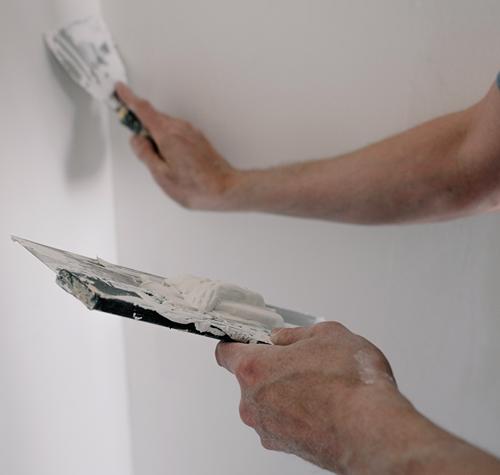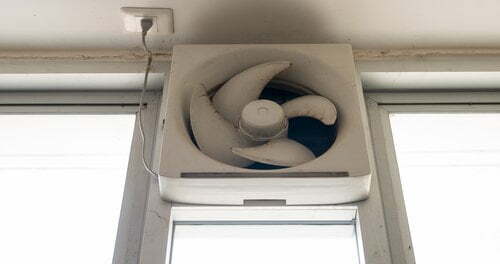Last Updated on January 1, 2024
It takes up to 10,000 liters of water for the construction and finishing of a family house. This includes tasks like concreting, plastering, screeding, painting, etc. and it may take anywhere from 1-2 years for it to dry down.
A good question: Do you need dehumidifier for your new home to assist in its drying process, or better, dry it faster?
Determining if your new home needs a dehumidifier depends on temperature, humidity, and ventilation inside it.
A dehumidifier is usually required for drying your new home if it is located in a humid area and lacks proper ventilation, especially in humid zones like bathrooms, kitchens, and basements, to prevent mold, mildew, and damage to construction.
Generally, ventilation as well as your AC or heater, whichever kind you are using, will serve to dry your home by regulating humidity.
However, depending on your area and air circulation in your home, this might not be sufficient. If that’s the case, consider using dehumidifiers in the humid zones of your home.
No need to worry—I’ll navigate you from start to finish in deciding if your new construction calls for a dehumidifier.
And if so, where do you need to place it? Also, how to manage 1 unit for multiple spaces? Moreover, there are strategies to enhance airflow for drying a new home that may not require you to use a dehumidifier.
As an extra, let’s understand who is responsible for drying a new construction. How to make sure they take responsibility?

Why New Homes Need Dehumidification?
New or not, humidity needs to be controlled in your home for its well-being and also yours.
However, for new homes, you need extra regulation of humidity for 8000-10000 liters of water used up from setting its foundations up to its completion.
Only with proper ventilation, and with other drying techniques if necessary, including dehumidification, would you be able to dry it in a recommended time period of 12-24 months.
Below are some of the reasons why new homes naturally have relatively higher humidity levels, and thereby need extra drying:
1. Water Usage in Construction and Materials
Building a home is a sequential process from the laying of its foundations to renovation and decoration.
Concreting, bricklaying, screeding, plastering, etc. use a lot of water (up to 1000 buckets) in materials and mixtures. An extensive amount of water needs to be dried for construction to cure and harden.
Until all this water evaporates, the relative humidity in a new home will remain higher than usual.
2. Water in Drywall Compound

Joint compound, also called drywall compound and drywall mud, needs to be mixed with water to form a paste that is then spread onto drywall during its installation.
It takes somewhere from 3-5 days for it to dry down. During this time, drywall compound will contribute to higher humidity in your home.
3. Moisture in Paints, Primers and Coatings

Most common paints i.e., latex paints use water as a solvent. As the coat dries, water will be released into the atmosphere, contributing to higher humidity levels in your home.
Whether your home is new or not, you could employ a dehumidifier to dry paint quickly.
But not all paints are the same when it comes to drying. I actually wrote an article about the effects of dehumidifiers on different kinds of paints. If you like, you can give it a look here.
4. Severely Humid Weather Conditions
Humid weather not only increases the time a new construction takes to dry but it can also damage it, especially when ventilation is poor, leading to mold and mildew.
Wood and porous materials for example can warp and swell if humidity is really high outside and you don’t use a dehumidifier to supplement the drying process.
5. Sealants and Insulation

Windows, panels, wallpapers, etc. need sealants, adhesives, and insulation that contain water.
After installation, they will release water into your home’s environment during the drying process. This will be more noticeable if you simultaneously work with them in different areas of your new house.
Does Your New Home Need Dehumidifier? (Steps to Decide)
Now Coming to the golden question.
Do you need a dehumidifier in your newly built house?
Well, it depends on the relative humidity throughout the construction. Recommended relative humidity for a healthy household is between 35-50%.
Some hot spots for high humidity in your home include washrooms, laundry, kitchen, and basement.
In new homes, humidity also rises from the drying of materials and mixtures, not just the usual moist spots.
Parts of your home with insufficient ventilation or lack of air circulation will have elevated humidity levels within your home i.e., higher than 60%.
You can know this by a hygrometer or simply by a damp humid feeling, musty odors, warped wood, and condensation on windows. Over time, you’ll notice mold and mildew.
Then you can use a dehumidifier only in those overly humid spots to ensure they dry at an adequate rate.
Steps to pinpoint where you need a dehumidifier in your new home

Step 1: Detect Relative Humidity Throughout Your Home
I would start by knowing what humidity rating is in different parts of the home.
Generally higher humidity levels i.e., above 60%, give you that muggy, sticky feeling with sweat and high heat. However, I recommend using a humidistat for this purpose.
It is an inexpensive device that will help you a lot in knowing accurate humidity in any part of your home.
In fact, I selected one for you to save you research time. I chose it based on reliability, accuracy, and lifespan.
The reason I recommend SMARTRO SC42 Professional Digital Hygrometer is because of its high accuracy Swiss humidity sensors with tolerance of ±2%RH, which is pretty great for this price.
It can be manually calibrated and certified by Aerospace Institute for Metrology and Measurement Technology. Click here to view its specifications.
Step 2: Room-by-Room Humidity Check
Start checking the humidity in every room of your home. Recommended levels of humidity are between 35-50 %. However, above 60% is an alarming value.
Identify high-humidity areas in your home by using a hygrometer at various spots and zones in your bedrooms, living room, basement, washrooms, kitchen, and laundry.
I would recommend surveying at a time when there are no high moisture-generating activities like washing clothes or cooking food, showering, etc.
This way you wouldn’t mix if this humidity is due to any specific activity or lack of dehumidification and ventilation.
Step 3: Recording Humidity Readings at Different Spots
Now if you do get humidity significantly higher than the recommended range i.e., 35-50% in any room or part of that room, make a note of it.
For example, you can say, there was 68% humidity in the basement close to the east foundation. Or there was 73% humidity in the bedroom next to the kitchen 4 hours after it was used.
Now time to resolve those overly moist spots. Let’s not jump to dehumidifier right away. We’ll start with the most efficient option. We want to save on bills too.
Step 4: Maximize Natural Ventilation in Humid Zones (Option 1)

First, increase natural ventilation near the humid spots of your home that you have recorded in the previous steps.
- This could mean simply opening the windows nearby.
- If there are multiple windows, opening them collectively even a little bit would develop that crossflow that will help regulate relative humidity.
- Make sure nothing is blocking the air vents of your home.
- Try more spacious and expansive configurations by moving things around for air to pass through easily.
- Strategically opening windows and vents in your home will help regulate humidity and temperature in your home and save you a lot on your bills.
Try to do as much as you can to establish fresh air currents through your home, especially in those overly humid areas.
Then after sufficient time, like a couple of hours, you can recheck the relative humidity in those humid zones that you noted. See if the relative humidity is in a healthy range of 35-50% or at least lower than 60%.
Step 5: Try Available Mechanical Ventilation (Option 2)
Natural Ventilation can fall short for a variety of reasons including
- Not enough windows and vents.
- New home releases moisture at a higher rate for natural ventilation to handle.
- A less expansive layout that is too crowded with furniture and accessories.
If that’s the case, it is time to use one or more of the following mechanical ventilation methods.
Use what’s accessible, these are different options, you don’t need to have all or most of them necessarily (personally, I rely only on kitchen and washroom extract fans in my home).
1. Extractor or Ventilation fans

Ventilation fans help a lot in regulating humidity in overly humid places like bathrooms, kitchens, laundry rooms, basements, etc.
However, extractor and ventilation fans can be highly effective in areas of a new home that require extra drying, like freshly plastered walls, screed floors, or newly painted walls.
Better airflow in your home, specifically through zones of high moisture, will ensure a speedier drying of your home if it is newly made.
By the way, in case you don’t have extractor fan(s) installed by default, I came across a much more flexible option for ventilation the other day. Have a look at this dual fan setup that can be mounted on your windows.
This one that I really like is BIONAIRE 8.5″ Twin Window Fan. It can be mounted on windows just like a window AC with two high-speed fans that can act as intake as well as exhaust. It is remote-controlled and has 3 speeds to select from.
On top of that, it also has a thermostat to stop fans at your desired temperature. Here’s a cool demonstration video:
2. Whole-House Ventilation Systems

These systems will allow forced ventilation in all parts of your home.
If you see these air extract valves in your new home, this means you already have a whole-house ventilation system installed.
Then you can go ahead and tailor its functioning for the best humidity and temperature levels.
3. HRVs and ERVs

Heat Recovery Ventilators (HRVs) and Energy Recovery Ventilators (ERVs) are designed to improve air quality inside your home while regulating temperature.
ERV systems bring in fresh air from outside while maintaining humidity and saving energy in new homes. Unlike HRVs, they give you control over the moisture too.
If you would like to enhance ventilation by one of these systems, you will need to hire a licensed HVAC contractor for an on-site evaluation and installation.
4. Zoned Ventilation
For multi-story or larger homes, zoned ventilation systems divide the house into separate ventilation zones, ensuring each area receives the right amount of fresh air based on its unique requirements.
Step 6: Pinpoint Home Areas That Need Dehumidifier (Option 3)
There is a reason why I didn’t suggest a dehumidifier right away in those humid zones.
I prefer ventilation over dehumidification because it provides fresh air, improves indoor air quality, and is often a more efficient, environment-friendly, and adaptable option.
Here’s what to do after ventilation doesn’t work:
- After maximizing ventilation and airflow through your home with the methods in the previous steps, it is time to assess humidity in those overly humid zones that we noted.
- See how many ‘humid spots’ were you able to get in the healthy range and which of them you couldn’t.
- Those areas that still have high humidity (above 60%), even after optimizations, are the spots or zones in each room that need a dehumidifier.
- Now depending on the drying needs and space that needs dehumidification, you will need to select the appropriate size of the dehumidifier.
In one of my articles, I have shown a very simple way to choose the right capacity dehumidifier for a specific space. You can give it a look here.
This step-by-step strategy will make sure that you use dehumidifier only when and where it is necessary.
High Humidity in Your New Home: Don’t Ignore it!

Bricklaying, plastering, painting, drywalling, woodwork, tiling, screeding, all these tasks from construction to renovation, use about 10000 liters of water, directly or indirectly, that needs to dry in a matter of 1-2 years.
If you don’t allow adequate removal of humidity in your home by ventilation, dehumidification, and regulation of temperature, it will interfere with the required curing and hydration process.
As a result, the quality of construction will deteriorate with low durability and strength and this may damage wood, and metals in the form of swelling and rust.
If you still don’t control humidity, after a while, mold and mildew will eventually spread in your home. Not to talk about poor air quality that will affect your own well-being.
How Long to Run a Dehumidifier in a New House?

After identifying damp spots in your home that need dehumidification, you might think:
How much time do I need to run a dehumidifier in those spots?
The answer is simple: whatever brings relative humidity in the recommended range i.e., between 35 and 50 percent or at least below 60 percent.
Nowadays, you don’t need to worry about the time you need to run a dehumidifier in a specific space as most units today are equipped with a humidistat or humidity sensor.
With these automated units, you can select a desired humidity and also read the current humidity in those overly humid spaces. Most experts suggest selecting humidity value on you unit close to 45%.
Once dehumidifier(s) lower humidity to the desired level, it will turn OFF, and only turn back ON when dehumidification is needed again. This will prevent excessive drying and reduce electricity consumption.
One Dehumidifier, Multiple Humid Spots. How To Manage?
Well, in this scenario, depending on the size of the humid spaces you will have to strategically adjust
- Dehumidifier capacity or size.
- Placement and Position of dehumidifiers.
- Time duration for which you run them.

Example from a Real-life Scenario:
For example, let’s say your basement has a very high humidity of 65% because the foundations haven’t dried up yet. The laundry is also very moist and mucky with average humidity of 72%.
In this scenario if you have 1 unit, you may run it in the laundry right after you have washed clothes and during that with vents open and exhaust ON.
Then when humidity normalizes there, you may shift the dehumidifier to basement and run for a couple of hours there to get humidity close to desired 45%, a little lower is even better.
This way you can have 1 or 2 units that you may manage in multiple locations. Higher capacity means quicker dehumidification and better ability to use the same unit in multiple rooms and spaces.
This may not be the standard approach, but if it speeds up drying and protects construction then why not…
Who Is Responsible for Drying a New Home?

If there is a new house or apartment that is not drying within the expected timeline, this can lead to mold and mildew and eventually structural damage, not to talk about health problems.
If you’re a resident or owner of a new home and it’s not drying properly, the party at fault is usually the one who caused the issue that led to that high humidity.
In the end, it all comes down to the contract and how reliable it is. You cannot make a plumbing company liable for the design of the building, or an HVAC company for leaking foundations after they have installed their systems based on schematics.
But generally, if a contractor is hired from start to end, they are responsible for drying of new home.
Then a contractor can diagnose and contact specific subcontractors including the construction team framers, roofers, plumbers, electricians, waterproofing experts, HVAC engineers, and architects.
Solution: Have clear contracts and documentation to make sure new construction is in compliance. Best is to hire a professional legal consultant for this matter.
This way in case there is an error that led to improper drying and high humidity in specific zones of your home, you could make the responsible company liable for its mistakes.
When Are Dehumidifiers Not a Good Idea?
After carefully evaluating the exact location(s) that need dehumidification by this strategy you can effectively and efficiently normalize humidity in those overly humid zones.
But sometimes a dehumidifier may not be a good idea. Here are some conditions in which it is better to just avoid drying by dehumidifier.
1. Drying a Little Too Quicker
Drying your home quicker is great. But not always.
If you dry it too quickly you may end up not giving enough time for curing and hydration of concrete which can lead to reduced strength, cracking, and structural instability.
Similarly, if you are at the stage of plaster, drying it too quickly may cause cracking uneven textures, and comparatively poor adhesion.
Of course, in our case we are trying to bring down humidity in a home that is not drying at an adequate pace.
This is usually a concern using a dehumidifier in a space that doesn’t need one, or using a bigger capacity dehumidifier for long intervals of time.
2. Dehumidifier Effects on Oil- Based Paints

With paints, in some cases, you just lose energy without any effect, like with oil-based paints.
They are not as common as latex paints (water-based paints). But using dehumidifier would have almost no effect on them and you would use a lot of energy for nothing.
Dehumidifiers however can help dry water-based paints quicker. I actually wrote an article about the effects of dehumidifiers on different types of paints. Here’s the link, if you’d like to read.
3. Too Cold for Dehumidifier to Work

There are certain conditions and limits with which dehumidifier operates.
Some of them are manufacturer and model-specific, meaning vary from one dehumidifier unit to another, while others are universal limitations of using a dehumidifier.
Dehumidifiers work best above 41°F (5°C), but they start losing efficiency below 60°F (16°C). So, if things get chilly, their performance will notably drop.
4. Wrong Dehumidifier Size
Two specifications vary for each dehumidifier depending upon their model and manufacturer, dehumidifier capacity (usually measured in pints) and dehumidifier tank volume.
Dehumidifier Capacity is how much moisture your dehumidifier extracts from the environment in a matter of 24 hours.
For example, if your dehumidifier capacity is 50 pints, this means it will extract 50 pints of water from the surrounding environment in 24 hours.
If your basement or attic generates more moisture than that you will need a bigger unit i.e., with more pint capacity.
Dehumidifier Tank Volume/Capacity refers to its maximum holding capacity for water in liters or gallons.

For example, a 50 pints dehumidifier can have an average tank volume of 2 gallons.
On the other hand, this Midea Cube Dehumidifier, which I personally really like due to its innovative design, has a dehumidification capacity of 35 pints and a dehumidifier tank of 4.2 gallons.
The first one, even though it removes water faster, will shut off just after collecting 1.4 gallons, until you empty its tank.
My point is that even though Midea Cube dehumidifier has a lower dehumidification capacity, it will ultimately dehumidify more in a single run than usual units due to a higher tank volume.
This is how dehumidifier capacity and tank volume play together to define the speed at which the dehumidifier works and the time for which it can work.
5. When Ventilation Can Get the Job Done
Why not go with natural means for handling humidity, or drying your home, before considering a dehumidifier? This is my approach in this article.
- Start with natural ventilation, maximizing it as much as you can, this will naturally and efficiently replace stale air with fresh air regulating temperature and humidity.
- If that is not enough, try making Centralized or Room-specific Air Conditioners and Heaters more effective by making rooms more airy and increasing airflow.
- If that is insufficient, then you may consider forced ventilation like exhaust fans, cooker hoods, etc. Better if you make use of HRVs and ERVs. But not every place has that. Like my place doesn’t have any system of such kind.
- If natural and mechanical ventilation, along with heating/cooling, and other available options fall short, dehumidifiers become necessary. I refer to them as the final choice because they are a pricier solution.
Can AC or Heater Do the Dehumidifier’s Job?
Both AC and heater lower relative humidity in their own way.
As this article is based on new homes, it depends on your home’s existing ventilation and drying stage.
AC extracts humidity by condensation, but they do it as a secondary function when air comes in contact with icy coils.
Heater naturally lowers relative humidity in your home by raising temperature. Actually, with same amount of moisture in the air, temperature inversely effects relative humidity.
Pro Tip: Run AC or Heating Systems as much as you need for a comfortable temperature.
Then find out different spots in your home that need dehumidification with techniques in this article. Use dehumidifier only in those spots.




